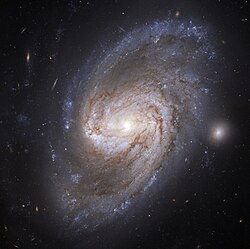Astronomy:NGC 3583
| NGC 3583 | |
|---|---|
 NGC 3583 as seen by the Hubble Space Telescope | |
| Observation data (J2000 epoch) | |
| Constellation | Ursa Major |
| Right ascension | 11h 14m 10.9s[1] |
| Declination | 48° 19′ 07″[1] |
| Redshift | 0.007022 ± 0.000010 [1] |
| Helio radial velocity | 2,105 ± 3 km/s[1] |
| Distance | 90.5 ± 10.2 Mly (27.7 ± 3.1 Mpc)[1] |
| Apparent magnitude (V) | 11.2 |
| Characteristics | |
| Type | SB(s)b [1] |
| Apparent size (V) | 3.04′ × 1.16′[1] |
| Other designations | |
| UGC 6263, MCG +08-21-008, PGC 34232, 5C 02.203[1] | |
NGC 3583 is a barred spiral galaxy located in the constellation Ursa Major. It is located at a distance of circa 90 million light years from Earth, which, given its apparent dimensions, means that NGC 3583 is about 85,000 light years across. It was discovered by William Herschel on February 5, 1788.[2]
NGC 3585 has a bright nucleus and an elliptical bulge.[3] It has a prominent bar which is about 30 arcseconds long.[4] The spiral arms start approximately at the radius of the end of the bar. One arm emanates from northwest edge of the bulge. At its start is quite diffuse but after passing near the bar becomes better defined. After reaching the southeast part of the galaxy it starts to fade. The other arm emanates from the southeast end of the bar. It appears to branch after passing from the other side of the bar, with the two branches running parallelly.[3]
The galaxy has many HII regions.[4] The star formation rate in the galaxy based on the infrared luminosity is 9.8 M☉ per year.[5] Two supernovae have been observed in NGC 3583, SN 1975P and ASASSN-15so.[6] ASASSN-15so was a type Ia supernova which was discovered 10 days before maximum light.[7]
NGC 3583 is the foremost galaxy in the NGC 3583 galaxy group. Also member of the group is the galaxy NGC 3595, while a bit farther away lies NGC 3614 and its group.[8] NGC 3583 forms a pair with a small elliptical galaxy, which lies 0.9 arcminutes from NGC 3583. Barred spiral galaxy NGC 3577 lies at a projected distance of 5 arcminutes.[9]
References
- ↑ 1.0 1.1 1.2 1.3 1.4 1.5 1.6 1.7 "NASA/IPAC Extragalactic Database". Results for NGC 3583. http://ned.ipac.caltech.edu/cgi-bin/nph-objsearch?objname=NGC+3583. Retrieved 2023-07-04.
- ↑ Seligman, Courtney. "NGC 3583". https://cseligman.com/text/atlas/ngc35a.htm#3583. Retrieved 19 November 2018.
- ↑ 3.0 3.1 Eskridge, Paul B.; Frogel, Jay A.; Pogge, Richard W.; Quillen, Alice C.; Berlind, Andreas A.; Davies, Roger L.; DePoy, D. L.; Gilbert, Karoline M. et al. (November 2002). "Near‐Infrared and Optical Morphology of Spiral Galaxies". The Astrophysical Journal Supplement Series 143 (1): 73–111. doi:10.1086/342340.
- ↑ 4.0 4.1 Fridman, A. M.; Afanasiev, V. L.; Dodonov, S. N.; Khoruzhii, O. V.; Moiseev, A. V.; Sil'chenko, O. K.; Zasov, A. V. (January 2005). "The orientation parameters and rotation curves of 15 spiral galaxies". Astronomy & Astrophysics 430 (1): 67–81. doi:10.1051/0004-6361:200400087.
- ↑ Misiriotis, A.; Papadakis, I. E.; Kylafis, N. D.; Papamastorakis, J. (April 2004). "Dust masses and star formation in bright IRAS galaxies: Application of a physical model for the interpretation of FIR observations". Astronomy & Astrophysics 417 (1): 39–50. doi:10.1051/0004-6361:20035602.
- ↑ "Bright Supernova pages - Most prolific galaxies". https://www.rochesterastronomy.org/snimages/sndupe.html.
- ↑ Zhang, Xiliang; Zhang, Jujia; Dong, Subo; Stanek, K. Z. (1 November 2015). "Spectroscopic Classification of ASASSN-15so as a young Type Ia Supernova". The Astronomer's Telegram 8261: 1. https://www.astronomerstelegram.org/?read=8261.
- ↑ Makarov, Dmitry; Karachentsev, Igor (21 April 2011). "Galaxy groups and clouds in the local (z~ 0.01) Universe". Monthly Notices of the Royal Astronomical Society 412 (4): 2498–2520. doi:10.1111/j.1365-2966.2010.18071.x. Bibcode: 2011MNRAS.412.2498M. http://www.sao.ru/hq/dim/groups/galaxies.dat. Retrieved 25 November 2018.
- ↑ de Vaucouleurs, G.; de Vaucouleurs, A.; Corwin, J. R. (1 January 1976). "Second reference catalogue of bright galaxies". Second Reference Catalogue of Bright Galaxies 1976. Bibcode: 1976RC2...C......0D. https://ui.adsabs.harvard.edu/abs/1976RC2...C......0D/abstract.
External links
- NGC 3583 on WikiSky: DSS2, SDSS, GALEX, IRAS, Hydrogen α, X-Ray, Astrophoto, Sky Map, Articles and images
 |

